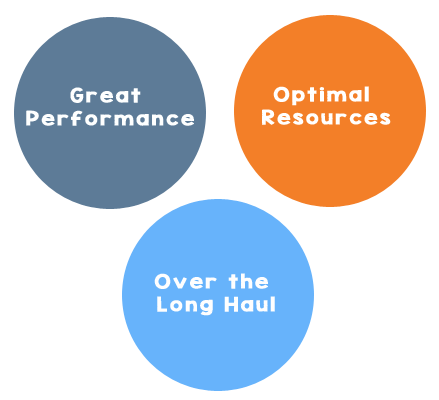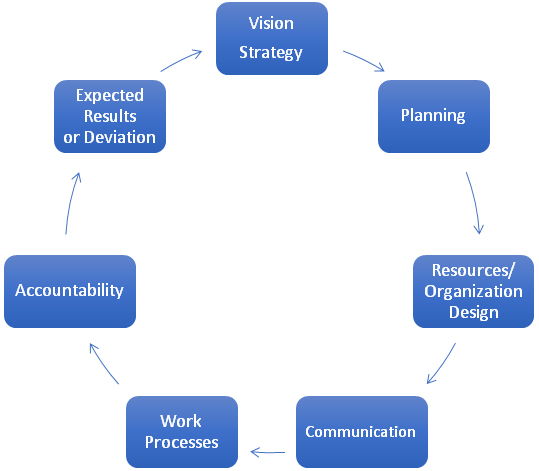Organizational Effectiveness Definition

My organizational effectiveness definition equates to great performance with optimal resources over the long haul.
There are three components to my organizational effectiveness definition. Change one of them, and you haven’t optimized your performance as a leader. If your financial performance is only because of rising market conditions, you’re presiding, not leading;
all boats rise with the tide! You can get great results in the short term, but that isn’t great performance. You can get those results with the wrong number or quality of resources, but that isn’t optimal performance either.
Let’s go a bit deeper.
Great Performance
Good organizations achieve great results when compared with their peers. In a public company, this is measured by the return on invested capital being higher than others in their sector. In private companies, owners’ organizational effectiveness definition includes in whichever way (legally!) they want. Whether public or private, I hope that those results also consider other stakeholders (e.g., employees, customers and communities). Customers, employees and ownership must all be satisfied for the game to go on!
A smooth-looking operation that isn’t results-oriented is doomed. More fluff than stuff only works briefly. How are you doing compared with others in your market or industry?
Optimal Resources
Organizational effectiveness also means you achieve those results with optimal (not minimal!) resources. Stretching people, machines or capital to the breaking point isn’t a long-term good practice and will come back to bite you in the butt. All companies endure tough periods when things are overextended. Being the low-cost provider can be a successful strategy, but death-bed-lean as a business model is dangerous. Likewise, too many people or too much capital to get your results is wasteful and inefficient.
In addition to a healthy return on sales, do you have a strong balance sheet, happy employees and a plan to keep risk at a rational level?
Over the Long Haul
Lastly, is your organization set up for success over the long haul? I grant you that the definition of “long haul” has changed and disruption is a fact of life, but a brilliant quarter or even year of results doesn’t make you a good leader, even if you get a large bonus.
Do you have all the right components in your company to achieve sustainable success?
Companies achieve organizational effectiveness by looking at the whole business; identifying and evaluating key components; planning for the future; putting the right people, systems and processes in place; and monitoring and course correcting frequently. Oh, and it must support your strategy!
The Roadmap to Organizational Effectiveness
How can you build organizational effectiveness? Here’s a roadmap:
-
1
Have a compelling vision (Where are we going?) and strategy (What are we doing toget there?). If you don’t, start there. (Click here if you want to learn about business strategy.)
-
2
Build a committed team of talented people. Commitment requires four things:
-
a
A higher purpose. Call it a vision, mission or purpose, but people want a real reason to come to work.
-
b
A clear idea about how to add value at work. Folks need real responsibilities that allow them to contribute.
-
c
The autonomy to do the job without too much “help” from above. Tell them what results you’d like to achieve, and let them figure out how best to do it. Yes, train them and develop them, but allow them the freedom and flexibility that tie them emotionally to the company.
-
d
Real feedback. Let team members know when they’re doing great and tell them when they need to improve. This all starts in the CEO’s office. In fact, organizational effectiveness is the direct result of the CEO’s leadership and the actions he or she takes.
-
-
3
Possess the right assets. Capital, intellectual property, technology, physical plants, etc. Don’t bring a knife to a gunfight!
-
4
Build an effective “operating system” that defines how the company does things. The chart to the right provides the basics. There should be effective processes that support each box. If not, you’re not nearly as efficient as you should be.

-
5
Assume a healthy culture that supports the company’s vision, values and strategy. If there’s a term more shrouded in mist than “strategy,” it’s “culture.” My definition of culture is “the sum of the behaviors that you reward and accept.” Period. There are two great questions to understanding an organization’s culture: “Who are the heroes around here?” and “What’s most likely to get me fired?” Don’t overcomplicate it!
This is all actionable! Don’t get overwhelmed. The hard part isn’t finishing (you never do!); the hard part is starting!
Organizational effectiveness is something some entrepreneurs and creative leaders don’t like to think about. In some ways, it’s the “heavy lifting” of management. It requires planning, systems thinking, follow up, accountability and a long attention span. If this isn’t in your makeup, hire a COO or start another company.
Think about organizational effectiveness as the quality of the route you’ll take to success. You know where you’re going (vision and strategy), but would you rather take a washed-out dirt road or a superhighway with no speed limit?